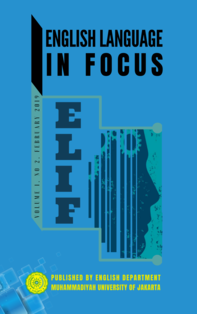Morphological Errors Analysis on Students’ Synopsis Writing
DOI:
https://doi.org/10.24853/elif.1.2.81-88Keywords:
morphological errors, students’ synopsis writing.Abstract
The objective of the study is to find out the students’ morphological errors in synopsis writing. It aimed to know what the difficulty is faced by the students in their synopsis writing. The methodology of study is a qualitative that focused to analyze the students’ synopsis writing errors. The research finding is found that several students have synopsis writing errors in some aspects refer to omission, misordering, misinformation, and addition.References
Brown, H. D. (2003). Language Assessment: Principles and Classroom Practices. California: San Francisco State University.
Dulay, H. C., Burt, M. K., & Krashen, S. D. (1982). Language Two. New York: Oxford University Press.
Kennedy, X. J., Kennedy, D. M., & Muth, M. F. (2011). The Bedford Guide for College Writers with Reader, Research Manual, and Handbook (9th ed.). Bedford/St. Martins.
Usha, P., & Kader, N. A. (2016). Syntactic and Morphological Error Analysis in English Language among Secondary School Students of Kerala. IOSR Journal of Humanities and Social Science (IOSR-JHSS, 21(2), 99–103. https://doi.org/10.9790/0837-2121991063
Downloads
Published
2019-02-27
Issue
Section
Articles
License
Authors who publish with this journal agree to the following terms:
- Authors retain copyright and grant the journal right of first publication with the work simultaneously licensed under a Creative Commons Attribution License that allows others to share the work with an acknowledgment of the work's authorship and initial publication in this journal.
- Authors can enter into separate, additional contractual arrangements for the non-exclusive distribution of the journal's published version of the work (e.g., post it to an institutional repository or publish it in a book), with an acknowledgment of its initial publication in this journal.
- Authors are permitted and encouraged to post their work online (e.g., in institutional repositories or on their website) before and during the submission process, as it can lead to productive exchanges, as well as earlier and greater citation of published work (See The Effect of Open Access).

